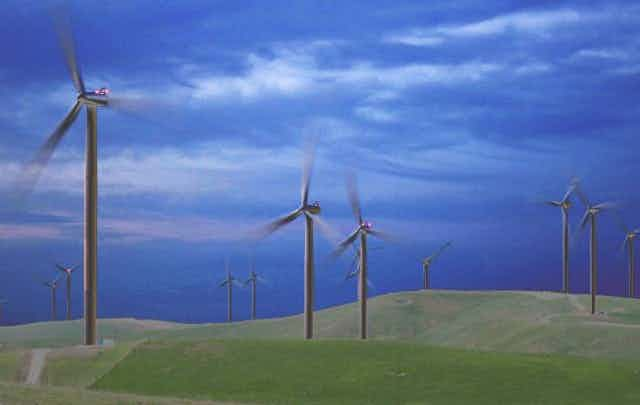In the year 1800, the world used only about 10 million tonnes of coal – renewable energy, mainly biomass, dominated world’s energy supply.
By 2013, fossil fuels together supplied more than 11 billion tonnes of coal equivalent, or 87% of global commercial energy. Renewable energy sources supplied under 9% and nuclear power the remainder.
In the coming decades, fossil fuel depletion and the need to respond to climate change will ensure that fossil fuel use will fall. Because it is unlikely that either renewable or nuclear energy can take over the dominant role fossil fuels presently enjoy, I argue that the energy available to humanity will decline, and we will need to adapt to a lower energy future.
Fossil fuels’ twin constraints
The likely future production profile for fossil fuels is controversial. Nevertheless, even the International Energy Agency now accepts that peak production for conventional oil has already occurred. One recent study even argues that if business-as-usual fossil fuel use continues, combined use could peak in a decade or so.
Unconventional fossil fuel resources are probably large. However, their monetary, environmental, and carbon dioxide costs per unit of energy delivered are much larger than for conventional fuels, limiting their future use.
Especially in the US, much hope has been placed on unconventional (tight) gas, extracted by fracking. But a recent study of tight gas fields casts doubt on this optimism. Actual gas production could in future be much lower than official US forecasts. It could even peak in the next decade or so, then decline rapidly.
If the world does take climate change seriously, we would then have to leave most fossil fuels in the ground, which would be bad news indeed for fossil fuel corporations.
Could nuclear energy fill the gap?
Global nuclear output locally peaked in 2006, and was still below that value in 2013. Nuclear’s share of global electricity peaked at 17% in 1993, and by 2013 had fallen to 11%. Even the US Energy Information Administration doesn’t expect much improvement; they forecast average annual growth of 2.5% for nuclear power globally out to 2040, compared with 1.5% for all energy sources.
A key problem in rapidly expanding nuclear output is an ageing reactor fleet – in mid-2013 the weighted average age for reactors was 28 years, and rising. Over 190 nuclear plants (45%) worldwide have operated for 30 years or more. Given this ageing nuclear fleet, much new construction will be needed merely to replace retiring plants, and will not add to net capacity.
Nuclear energy is also very expensive. The cost of a 1000 megawatt plant in the US in 2009 was estimated at US$9 billion. Decommissioning old plants adds a further heavy cost, and could take decades.
The UK government now estimates that clean-up costs for the Sellafield reprocessing plant alone will be £80 billion. And despite nearly 60 years of commercial nuclear power, no permanent waste disposal repositories are in operation.
A final point. Uranium reserves may not be sufficient to support for long even a modest upturn in nuclear power, should it ever occur.
Renewable energy: essential but limited
The world has a variety of renewable sources available. Bio-mass and hydro-power are the two leading ones, but wind, geothermal, tidal and solar energy all presently contribute to global energy supply.
The only abundant renewable sources are wind and solar energy (and Australia is well supplied with both), but both are intermittent energy sources: they don’t generate without wind or sunlight. Hence reliance on renewables, not only for electricity but for other energy uses, will require conversion and storage of these intermittent energy sources.
This need for conversion and storage will raise renewable costs for each unit of energy delivered to the consumer. There is however, a further problem. Obviously, for any energy source to be viable, it must produce more energy output than the various energy inputs needed to construct and operate it – the energy ratio must be much greater than one. This ratio is already lower for renewable than for fossil fuel sources, and the need for energy storage and conversion will further lower it.
All energy sources have environmental costs, including renewable energy. Those for large hydro systems are well-known. Bio-energy crops such as ethanol from corn compete with crops grown for food for water and fertile soils. The adverse effects of these two renewable sources are better-known mainly because their output is highest.
Our low-energy future
The world will eventually have to rely again on renewable energy sources, just as it did at the start of the fossil fuel era around 1800. There is a big difference this time: in 1800 the world’s population was only about a billion. Today it is 7.3 billion, and still rising. We’ll never again have the high-energy society of the carbon civilisation.
Instead we’ll have to prepare for a low-energy future. Improving technical efficiency of energy use can help, but so far has not prevented global energy use from steadily rising.
Using less energy means less use of equipment — vehicles, air-conditioning, and other household appliances. Buildings will need to use passive solar energy more for heating, cooling, and even lighting, and generate some power from rooftop solar systems. Gardens could grow more fruit and vegetables. Households in dry regions can install tanks for rainwater.
What changes are needed for cities and their transport systems? For transport we must shift from our obsession with vehicular mobility to a focus on accessibility. Public transport will need to increase its share of a much smaller vehicular travel task. Activities will need to be more localised. Non-motorised modes can then be a major form of urban travel.
So we’ll need social efficiency improvements – we’ll need to rediscover ways of satisfying our needs with less use of energy-using devices. We can learn from earlier generations – how did they cope with far lower energy levels? We might even have something to learn from the more creative practices of presently low-energy societies.

